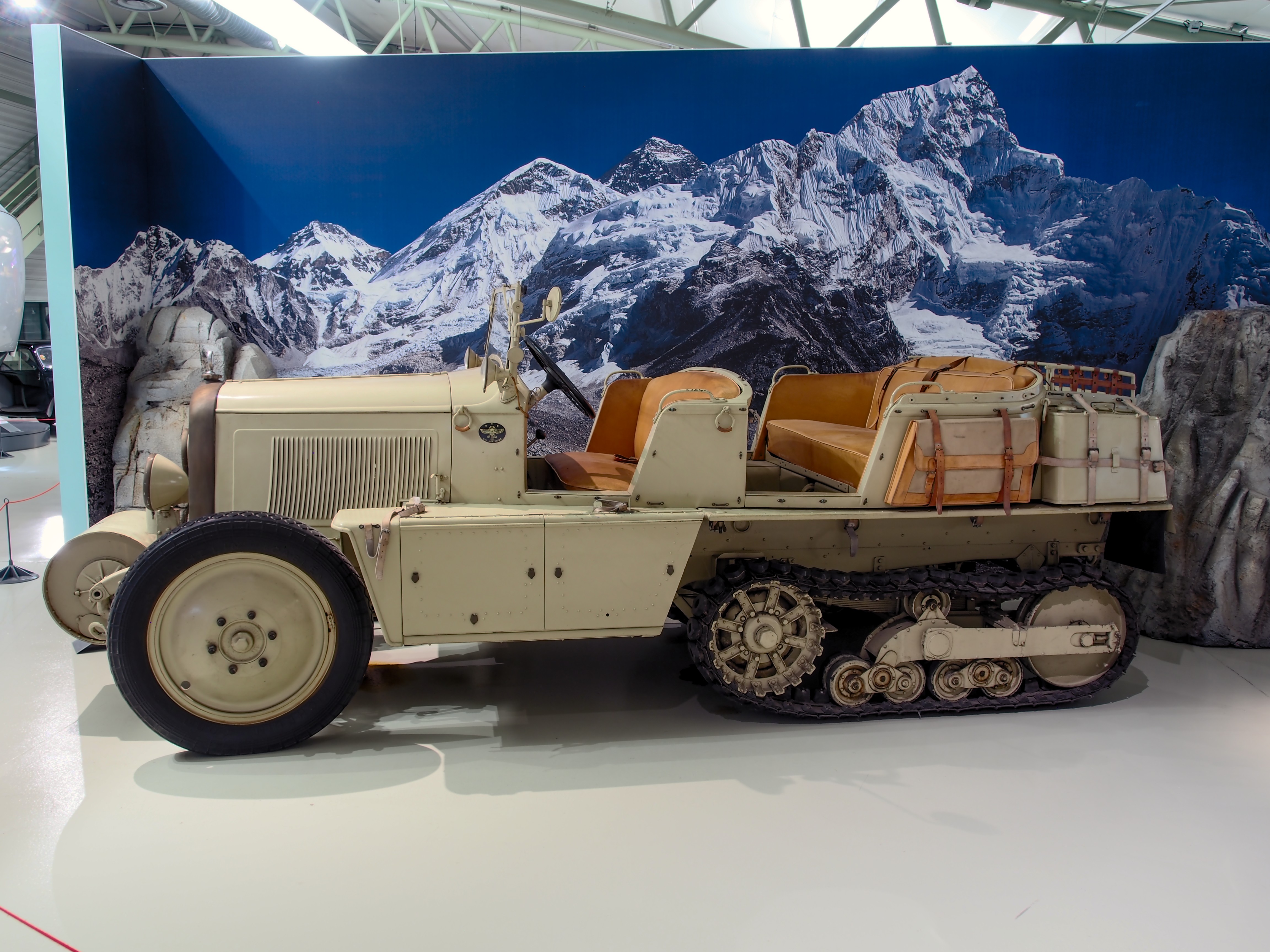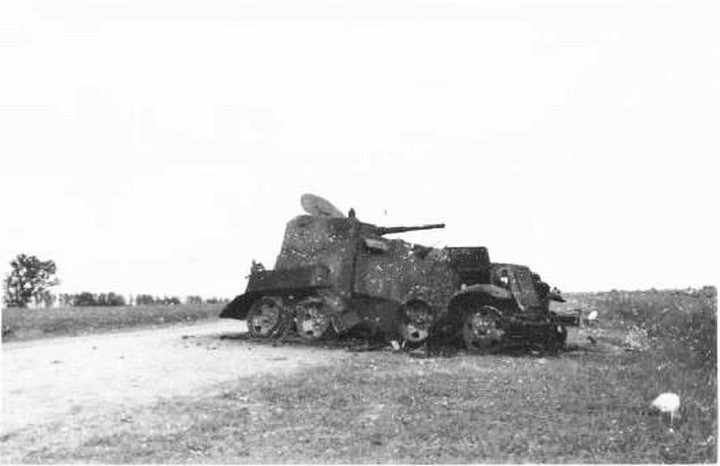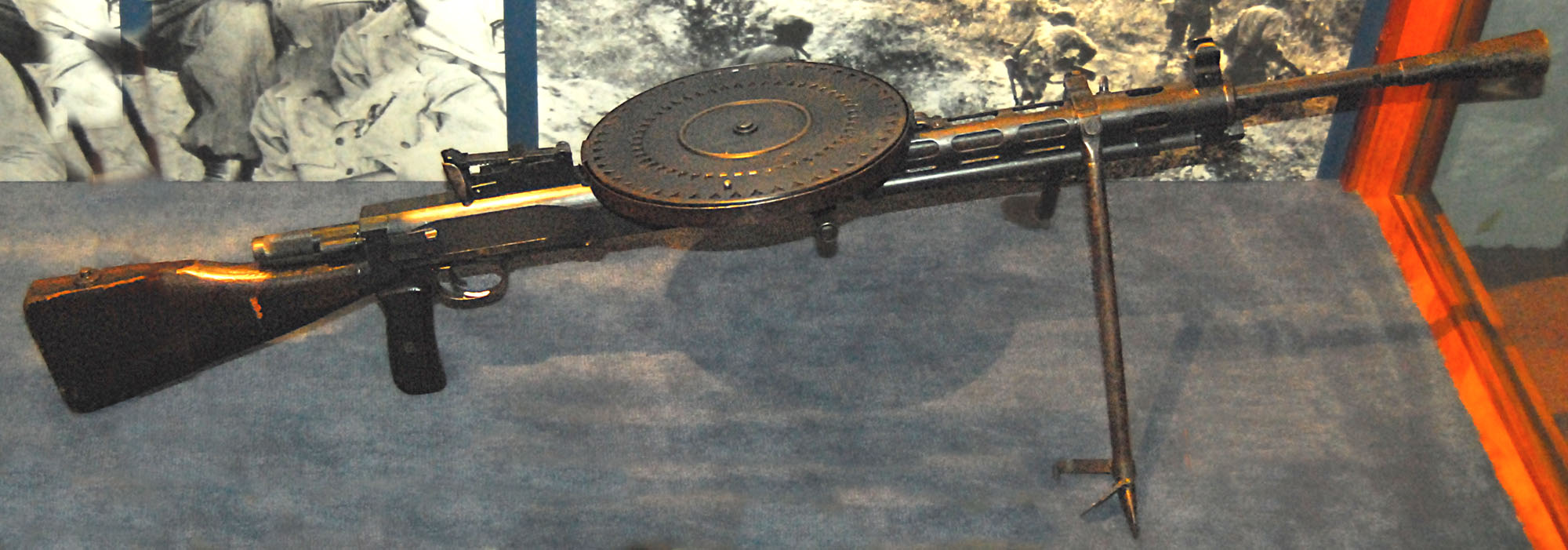|
BA-3
The BA-3 (russian: Broneavtomobil 3) was a heavy armored car developed in the Soviet Union in 1933, followed by a slightly changed model BA-6 in 1936. Both were based mostly on BA-I, the most important development being the new turret, same as in the T-26 m 1933 and BT-5 tanks, and also equipped with the 45 mm main gun. 221 BA-3 cars were built at the Izhorskij and Vyksunskij factories, until production ended in 1935. BA-6 followed with 386 cars produced between 1936 and 1938 in Izhorskij factory. Most BA-3 production was based on the Ford-Timken chassis, a 6×4 modification of the US Ford AA 4×2 truck, but the last batch was built on the Russian version of the same chassis - GAZ-AAA, and continued to be used in the BA-6. The biggest limitation of the BA-3 was the mobility, limited to roads or very hard ground, the result of unnecessarily large weight. The innovation that slightly improved mobility were the auxiliary ("Overall") tracks that could be fitted onto the rea ... [...More Info...] [...Related Items...] OR: [Wikipedia] [Google] [Baidu] |
BA-I
The BA-I (sometimes BAI) is a Soviet three-axle armoured car. Only 82 vehicles of this type were built in 1932-1934, nevertheless the design initiated a series of heavy armoured cars of Izhorskij plant: BA-3, BA-6, BA-9, and BA-10. Some vehicles were used in World War II, despite being obsolete at the time. Background In 1931, the first Soviet 6x4 chassis was created, a design based on adding Timken tandem rear axles to the American Ford AA chassis, and because of that called ''Ford-Timken''. This immediately initiated the development of armoured cars. By the end of the year assembly was taking place at the plant "Gudok Oktyabrya" in Kanavin, near Nizhniy Novgorod. In autumn of the same year at the Repair Base of Nº2 in Moscow hull from the BA-27 armoured car was first attached to the new chassis. About 20 such cars were built, having the designation BA-27M. At the same time, and with the same chassis, but at the Izhorskij plant, several dozen D-13 armoured cars were bui ... [...More Info...] [...Related Items...] OR: [Wikipedia] [Google] [Baidu] |
Half-track
A half-track is a civilian or military vehicle with regular wheels at the front for steering and continuous tracks at the back to propel the vehicle and carry most of the load. The purpose of this combination is to produce a vehicle with the cross-country capabilities of a tank and the handling of a wheeled vehicle. Performance The main advantage of half-tracks over wheeled vehicles is that the tracks reduce the pressure on any given area of the ground by spreading the vehicle's weight over a larger area, which gives it greater mobility over soft terrain like mud and snow, while they do not require the complex steering mechanisms of fully tracked vehicles, relying instead on their front wheels to direct the vehicle, augmented in some cases by track braking controlled by the steering wheel. It is not difficult for someone who can drive a car to drive a half-track, which is a great advantage over fully tracked vehicles, which require specialized training. Half-tracks thus facil ... [...More Info...] [...Related Items...] OR: [Wikipedia] [Google] [Baidu] |
BA-10
The BA-10 ( ru , Broneavtomobil 10, italic=yes) was an armored car developed in the Soviet Union in 1938 and produced through 1941. It was the most produced Soviet pre-1941 heavy armored car – 3311 were built in three versions. These versions were the BA-10, the BA-10M (improved version with new radio), and the BA-10ZhD (equipped for dual railway/road use). The basic BA-10 design was developed from the BA-3 and BA-6 heavy armored cars. It had an improved GAZ-AAA chassis and improved armor (up to 15mm at front and turret). It was intended that the BA-10 would be replaced in 1941 by the BA-11 with diesel engine and more sophisticated armor design, but the outbreak of war prevented BA-11 production. The BA-10 was in Red Army service until 1945. Significant numbers of captured BA-10s were used by Finland (at least 24), Germany and other Axis powers in Europe. Development During the late 1930s, Soviet armoured fighting vehicle designers incorporated sloped armor into all their ... [...More Info...] [...Related Items...] OR: [Wikipedia] [Google] [Baidu] |
45 Mm Anti-tank Gun M1932 (20-K)
The 45 mm anti-tank gun model 1932 (factory designation 19-K and GRAU index 52-P-243A) was a light quick-firing anti-tank gun used in the interwar period and in the first stage of the German-Soviet War. It was created by factory No. 8 which was located in now Korolyov city, under leadership of engineer V. Bering. History The gun bearing factory designation 19-K (Cyrillic ''19-К'') was a combination of a modified carriage of the 37 mm anti-tank gun model 1930 (built according to a documentation bought from Rheinmetall) with a 45 mm barrel designed in March 1932. and adopted by the Red Army on March 23, 1932. The 45 mm caliber was selected because the large reserves of the French 47 mm shells could be converted to 45 mm by milling out the driving bands. The resulting light quarter-automatic anti-tank gun was discovered to be unsatisfactory due to low mobility and reliability problems, and after a series of modifications (including the arrest of ... [...More Info...] [...Related Items...] OR: [Wikipedia] [Google] [Baidu] |
Battle Of Khalkhyn Gol
The Battles of Khalkhin Gol (russian: Бои на Халхин-Голе; mn, Халхын голын байлдаан) were the decisive engagements of the undeclared Soviet–Japanese border conflicts involving the Soviet Union, Mongolia, Japan and Manchukuo in 1939. The conflict was named after the river Khalkhin Gol, which passes through the battlefield. In Japan, the decisive battle of the conflict is known as the after Nomonhan, a nearby village on the border between Mongolia and Manchuria. The battles resulted in the defeat of the Japanese Sixth Army. Background After the Japanese occupation of Manchuria in 1931, Japan turned its military interests to Soviet territories that bordered those areas. The first major Soviet-Japanese border incident, the Battle of Lake Khasan, occurred in 1938 in Primorye. Clashes between Japanese and Soviet forces occurred frequently along the border of Manchuria. In 1939, Manchuria was a puppet state of Japan known as Manchukuo, and Mo ... [...More Info...] [...Related Items...] OR: [Wikipedia] [Google] [Baidu] |
Spanish Civil War
The Spanish Civil War ( es, Guerra Civil Española)) or The Revolution ( es, La Revolución, link=no) among Nationalists, the Fourth Carlist War ( es, Cuarta Guerra Carlista, link=no) among Carlists, and The Rebellion ( es, La Rebelión, link=no) or The Uprising ( es, La Sublevación, link=no) among Republicans. was a civil war in Spain fought from 1936 to 1939 between the Republicans and the Nationalists. Republicans were loyal to the left-leaning Popular Front government of the Second Spanish Republic, and consisted of various socialist, communist, separatist, anarchist, and republican parties, some of which had opposed the government in the pre-war period. The opposing Nationalists were an alliance of Falangists, monarchists, conservatives, and traditionalists led by a military junta among whom General Francisco Franco quickly achieved a preponderant role. Due to the international political climate at the time, the war had many facets and was variously viewed as cla ... [...More Info...] [...Related Items...] OR: [Wikipedia] [Google] [Baidu] |
World War II Armoured Fighting Vehicles Of The Soviet Union
In its most general sense, the term "world" refers to the totality of entities, to the whole of reality or to everything that is. The nature of the world has been conceptualized differently in different fields. Some conceptions see the world as unique while others talk of a "plurality of worlds". Some treat the world as one simple object while others analyze the world as a complex made up of many parts. In ''scientific cosmology'' the world or universe is commonly defined as " e totality of all space and time; all that is, has been, and will be". '' Theories of modality'', on the other hand, talk of possible worlds as complete and consistent ways how things could have been. ''Phenomenology'', starting from the horizon of co-given objects present in the periphery of every experience, defines the world as the biggest horizon or the "horizon of all horizons". In ''philosophy of mind'', the world is commonly contrasted with the mind as that which is represented by the mind. ''Th ... [...More Info...] [...Related Items...] OR: [Wikipedia] [Google] [Baidu] |
Armoured Cars Of The Interwar Period
Armour (British English) or armor (American English; see spelling differences) is a covering used to protect an object, individual, or vehicle from physical injury or damage, especially direct contact weapons or projectiles during combat, or from a potentially dangerous environment or activity (e.g. cycling, construction sites, etc.). Personal armour is used to protect soldiers and war animals. Vehicle armour is used on warships, armoured fighting vehicles, and some mostly ground attack combat aircraft. A second use of the term ''armour'' describes armoured forces, armoured weapons, and their role in combat. After the development of armoured warfare, tanks and mechanised infantry and their combat formations came to be referred to collectively as "armour". Etymology The word "armour" began to appear in the Middle Ages as a derivative of Old French. It is dated from 1297 as a "mail, defensive covering worn in combat". The word originates from the Old French , itself derived ... [...More Info...] [...Related Items...] OR: [Wikipedia] [Google] [Baidu] |
Degtyaryov Machine Gun
The Degtyaryov machine gun (russian: Пулемёт Дегтярёвa Пехотный, Pulemyot Degtyaryova Pekhotny literally: "Degtyaryov's infantry machine gun") or DP-27/DP-28 is a light machine gun firing the 7.62×54mmR cartridge that was primarily used by the Soviet Union, with service trials starting in 1927, followed by general deployment in 1928. Besides being the standard Soviet infantry light machine gun (LMG) during World War II, with various modifications it was used in aircraft as a flexible defensive weapon, and it equipped almost all Soviet tanks in WWII as either a flexible bow machine gun or a co-axial machine gun controlled by the gunner. It was improved in 1943 producing the DPM, but it was replaced in 1946 with the RP-46 which improved on the basic DP design by converting it to use belt feed. The DP machine gun was supplemented in the 1950s by the more modern RPD machine gun and entirely replaced in Soviet service by the general purpose PK machine gun in t ... [...More Info...] [...Related Items...] OR: [Wikipedia] [Google] [Baidu] |
DShK
The DShK 1938 (Cyrillic: ДШК, for russian: Дегтярёва-Шпагина Крупнокалиберный, Degtyaryova-Shpagina Krupnokaliberny, links=no, "Degtyaryov-Shpagin large-calibre") is a Soviet heavy machine gun with a V-shaped butterfly trigger, firing the 12.7×108mm cartridge. The weapon was also used as a heavy infantry machine gun, where it was frequently deployed with a two-wheeled mounting and a single-sheet armour-plate shield. The DShK's name is derived from its original designer, Vasily Degtyaryov, and Georgi Shpagin, who later improved the cartridge feed mechanism. It is sometimes nicknamed Dushka (a dear or beloved person) in Russian-speaking countries, from the abbreviation. Alongside the American M2 Browning, the DShK is the only .50 caliber machine gun designed prior to World War II that remains in service to the present day. History Requiring a heavy machine gun similar to the M2 Browning, development of the DShK began in the Soviet Union in 1929 an ... [...More Info...] [...Related Items...] OR: [Wikipedia] [Google] [Baidu] |
Finnish Army
The Finnish Army (Finnish: ''Maavoimat'', Swedish: ''Armén'') is the land forces branch of the Finnish Defence Forces. The Finnish Army is divided into six branches: the infantry (which includes armoured units), field artillery, anti-aircraft artillery, engineers, signals, and materiel troops. The commander of the Finnish Army since 1 January 2022 is Lieutenant General Pasi Välimäki. Role The duties of the Finnish Army are threefold. They are: [...More Info...] [...Related Items...] OR: [Wikipedia] [Google] [Baidu] |
T-70
The T-70 was a light tank used by the Red Army during World War II, replacing both the T-60 scout tank for reconnaissance and the T-50 light infantry tank for infantry support. The T-80 light tank was a more advanced version of the T-70 with a two-man turret—it was produced only in very small numbers when light tank production was abandoned. The T-90 self-propelled anti-aircraft gun was a prototype vehicle with twin machine guns, based on the T-70 chassis. The T-70 was armed with a 45-mm L/46 gun Model 38 with forty-five rounds carried, and a coaxial 7.62-mm DT machine gun. The tank was operated by a driver and a commander who loaded and fired the gun. Armour thickness on the turret front was 60 mm, turret sides and rear: 35 mm, hull front and sides: 45 mm, roof and bottom: 10 mm. Production history By 1942, light tanks were considered inadequate by the Red Army, unable to keep up with the T-34 medium tank and unable to penetrate the armour of most ... [...More Info...] [...Related Items...] OR: [Wikipedia] [Google] [Baidu] |






.jpg)

